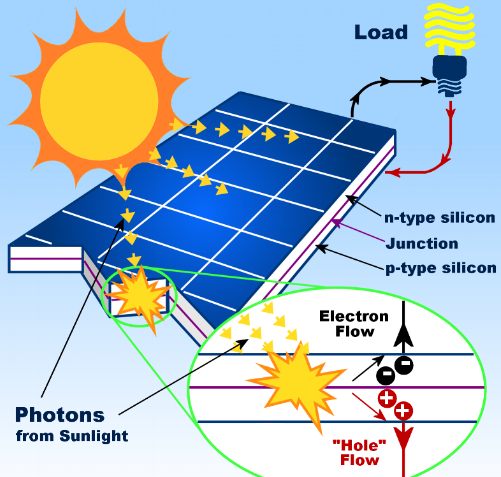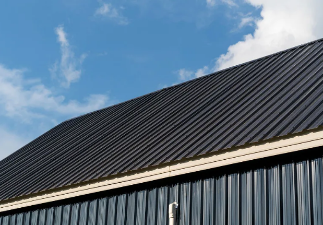As global energy becomes increasingly scarce, solar energy has been vigorously developed as a new energy source. Among them, solar cells are the most used in our lives. Solar panels are mainly made of semiconductor materials. Photoelectric materials absorb light energy and then undergo photoelectric conversion to generate current. So what is the working principle of solar panels? Solar cells are devices that directly convert light energy into electrical energy through photoelectric effect or photochemical effect. When sunlight shines on a semiconductor, part of it is reflected by the surface, and the rest is absorbed or transmitted by the semiconductor. Of course, some of the absorbed light turns into heat, and other photons collide with the atomic valence electrons that make up the semiconductor, thus generating electron-hole pairs. In this way, light energy is converted into electrical energy in the form of electron-hole pairs.
As global energy becomes increasingly scarce, solar energy has been vigorously developed as a new energy source. Among them, solar cells are the most used in our lives. Solar panels are mainly made of semiconductor materials. Photoelectric materials absorb light energy and then undergo photoelectric conversion to generate current. So what is the working principle of solar panels? Solar cells are devices that directly convert light energy into electrical energy through photoelectric effect or photochemical effect. When sunlight shines on a semiconductor, part of it is reflected by the surface, and the rest is absorbed or transmitted by the semiconductor. Of course, some of the absorbed light turns into heat, and other photons collide with the atomic valence electrons that make up the semiconductor, thus generating electron-hole pairs. In this way, light energy is converted into electrical energy in the form of electron-hole pairs.
- Working principle of solar cells
The basis of solar cell energy conversion is the photovoltaic effect of semiconductor PN junction. As mentioned above, when light shines on semiconductor photovoltaic devices, photons with energy greater than the silicon bandgap width pass through the anti-reflection film into the silicon, and stimulate photogenerated electron-hole pairs in the N region, depletion region and P region.
Depletion region: After the photogenerated electron-hole pairs are generated in the depletion region, they are immediately separated by the built-in electric field, and the photogenerated electrons are sent to the N region, and the photogenerated holes are pushed into the P region. According to the depletion approximation condition, the carrier concentration at the boundary of the depletion region is approximately 0, that is, p=n=0.
In the N region: After the photogenerated electron-hole pairs are generated, the photogenerated holes diffuse to the P-N junction boundary. Once they reach the P-N junction boundary, they are immediately affected by the built-in electric field and pulled by the electric field force to drift, crossing the depletion region into the P region, and the photogenerated electrons (majority carriers) are left in the N region.
In the P region: the photogenerated electrons (minority carriers) also enter the N region due to diffusion and then drift, and the photogenerated holes (majority carriers) remain in the P region. In this way, positive and negative charges are accumulated on both sides of the P-N junction, so that the N region stores excess electrons and the P region has excess holes. Thus, a photogenerated electric field opposite to the built-in electric field is formed.
- In addition to partially offsetting the effect of the barrier electric field, the photogenerated electric field also makes the P region positively charged and the N region negatively charged, and an electromotive force is generated in the thin layer between the N region and the P region. This is the photovoltaic effect. When the battery is connected to a load, the photocurrent flows from the P region through the load to the N region, and the power output is obtained in the load.
- If the two ends of the P-N junction are open, this electromotive force can be measured, which is called the open circuit voltage Uoc. For crystalline silicon cells, the typical value of the open circuit voltage is 0.5~0.6V.
- If the external circuit is short-circuited, a photocurrent proportional to the incident light energy will flow through the external circuit. This current is called the short-circuit current Isc.
Factors affecting photocurrent:
- The more electron-hole pairs generated in the interface layer by light, the greater the current.
- The more light energy absorbed by the interface layer, the larger the interface layer, i.e. the battery area, and the greater the current formed in the solar cell.
- The N region, depletion region and P region of the solar cell can all generate photogenerated carriers;
- The photogenerated carriers in each region must cross the depletion region before recombination to contribute to the photocurrent, so the actual photogenerated current must take into account various factors such as generation and recombination, diffusion and drift in each region.
Solar cell equivalent circuit, output power and fill factor
⑴ Equivalent circuit
In order to describe the working state of the battery, the battery and load system are often simulated by an equivalent circuit.
- Constant current source: Under constant illumination, the photocurrent of a working solar cell does not change with the working state. In the equivalent circuit, it can be regarded as a constant current source.
- Dark current Ibk: Part of the photocurrent flows through the load RL, establishing a terminal voltage U across the load. In turn, it is forward biased to the PN junction, causing a dark current Ibk in the opposite direction to the photocurrent.
- In this way, the equivalent circuit of an ideal PN homojunction solar cell is drawn as shown in the figure.
- Series resistance RS: Due to the contact between the front and back electrodes and the certain resistivity of the material itself, additional resistance is inevitably introduced in the base and top layers. When the current flowing through the load passes through them, it will inevitably cause loss. In the equivalent circuit, their total effect can be represented by a series resistance RS.
- Parallel resistor RSh: Due to leakage at the edge of the battery and leakage of metal bridges formed at microcracks and scratches when making metallized electrodes, part of the current that should pass through the load is short-circuited. The magnitude of this effect can be equivalent to a parallel resistor RSh.
When the current flowing into the load RL is I and the terminal voltage of the load RL is U, we can get:
The P in the formula is the output power obtained on the load RL when the solar cell is irradiated.
⑵ Output power When the current flowing into the load RL is I and the terminal voltage of the load RL is U, we can get:
The P in the formula is the output power obtained on the load RL when the solar cell is irradiated. When the load RL changes from 0 to infinity, the output voltage U changes from 0 to U0C, and the output current changes from ISC to 0, so the load characteristic curve of the solar cell can be drawn. Any point on the curve is called the working point, and the line connecting the working point and the origin is called the load line. The inverse of the slope of the load line is equal to RL, and the horizontal and vertical coordinates corresponding to the working point are the working voltage and working current.
When the load resistance RL is adjusted to a certain value Rm, a point M is obtained on the curve, and the product of the corresponding working current Im and working voltage Um is the largest, that is: Pm=ImUm
Point M is generally called the optimal working point (or maximum power point) of the solar cell, Im is the optimal working current, Um is the optimal working voltage, Rm is the optimal load resistance, and Pm is the maximum output power.
⑶ Fill factor
- The ratio of the maximum output power to (Uoc×Isc) is called the fill factor (FF), which is one of the important indicators used to measure the output characteristics of solar cells.
- The fill factor characterizes the quality of solar cells. Under a certain spectral irradiance, the larger the FF, the more "square" the curve is, and the higher the output power is.
- Efficiency of solar cells and factors affecting efficiency
⑴ Efficiency of solar cells:
When a solar cell is irradiated, the ratio η of output power to incident light power is called the efficiency of the solar cell, also known as photoelectric conversion efficiency. Generally refers to the maximum energy conversion efficiency when the external circuit is connected to the optimal load resistance RL.
In the above formula, if At is replaced by the effective area Aa (also called active area), that is, the area of the grid pattern is deducted from the total area, the calculated efficiency will be higher. This should be noted when reading domestic and foreign literature. Prince of the United States first calculated that the theoretical efficiency of silicon solar cells was 21.7%. In the 1970s, M. Wolf made a detailed discussion and also obtained that the theoretical efficiency of silicon solar cells was 20%~22% under AM0 spectral conditions, and later revised it to 25% (AM1.0 spectral conditions). To estimate the theoretical efficiency of solar cells, all possible losses from incident light energy to output electrical energy must be calculated. Some of them are losses related to materials and processes, while others are determined by basic physical principles.
⑵ Factors affecting efficiency In summary, to improve the efficiency of solar cells, it is necessary to improve the three basic parameters of open circuit voltage Uoc, short circuit current ISC and fill factor FF. These three parameters are often mutually restrained. If one of them is increased unilaterally, the other may be reduced, so that the total efficiency is not only not increased but decreased. Therefore, when selecting materials and designing processes, it is necessary to consider all aspects and strive to maximize the product of the three parameters.
- Material band width:
The open circuit voltage UOC increases with the increase of the band width Eg, but on the other hand, the short circuit current density decreases with the increase of the band width Eg. As a result, it is expected that the peak of the solar cell efficiency will appear at a certain Eg. Solar cells made of materials with Eg values between 1.2 and 1.6 eV are expected to achieve the highest efficiency. Direct bandgap semiconductors are more desirable for thin-film cells because they can absorb photons near the surface.
- Temperature:
The diffusion length of minority carriers increases slightly with the increase of temperature, so the photocurrent also increases with the increase of temperature, but UOC decreases sharply with the increase of temperature. The filling factor decreases, so the conversion efficiency decreases with the increase in temperature.
- Irradiance:
As irradiance increases, the short-circuit current increases linearly, and the maximum power increases continuously. Focusing sunlight on a solar cell can make a small solar cell generate a large amount of electricity.
- Doping concentration:
Another factor that has a significant impact on UOC is the semiconductor doping concentration. The higher the doping concentration, the higher the UOC. However, when the impurity concentration in silicon is higher than 1018/cm3, it is called high doping. The band gap shrinkage, the impurities cannot be completely ionized, and the minority carrier lifetime decrease caused by high doping are collectively referred to as high doping effects, which should also be avoided.
- Photogenerated carrier recombination life:
For the semiconductor of the solar cell, the longer the recombination life of the photogenerated carriers, the greater the short-circuit current will be. The key to achieving long life is to avoid the formation of recombination centers during material preparation and battery production. During the processing, appropriate and frequent related process treatments can remove the recombination centers and extend the life.
- Surface recombination rate:
A low surface recombination rate helps to increase Isc. The recombination rate on the front surface is difficult to measure and is often assumed to be infinite. A cell design called back field (BSF) is that before depositing metal contacts, a P+ additional layer is diffused on the back of the cell.
- Series resistance and metal grid lines:
Series resistance comes from the lead, metal contact grid or cell body resistance, and the metal grid lines cannot transmit sunlight. In order to maximize ISC, the area occupied by the metal grid lines should be minimized. Generally, making the metal grid lines dense and thin can reduce series resistance and increase the light transmission area of the cell.
- Use velvet cell design and select high-quality anti-reflection film:
Relying on the pyramid-shaped square cone structure on the surface, the light is reflected multiple times, which not only reduces the reflection loss, but also changes the direction of light in silicon and extends the optical path, increasing the production of photogenerated carriers; the tortuous velvet surface increases the area of the PN junction, thereby increasing the collection rate of photogenerated carriers, increasing the short-circuit current by 5% to 10%, and improving the red light response of the cell.
- The impact of shadows on solar cells:
Solar cells will be unevenly illuminated due to shadows, etc., and the output power will be greatly reduced.
At present, the application of solar cells has entered the industrial, commercial, agricultural, communication, household appliances and public utilities sectors from the military and aerospace fields. In particular, they can be used in remote areas, mountains, deserts, islands and rural areas to save expensive transmission lines. However, at the current stage, its cost is still very high. It takes tens of thousands of dollars to generate 1kW of electricity, so large-scale use is still subject to economic restrictions. In the long run, with the improvement of solar panel manufacturing technology and the invention of new light-to-electricity conversion devices, the protection of the environment and the huge demand for renewable clean energy in various countries, solar cells will still be a more practical way to utilize solar radiation energy, which can open up broad prospects for large-scale use of solar energy in the future.



